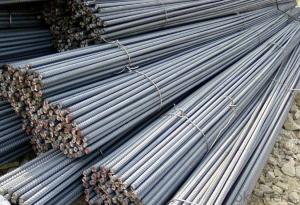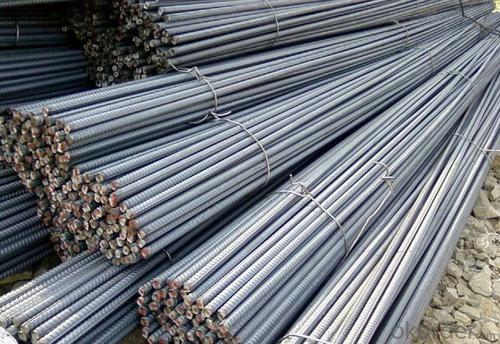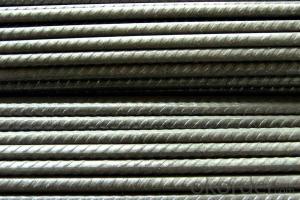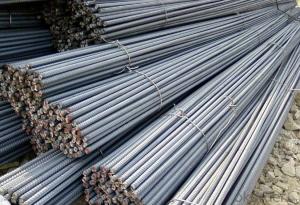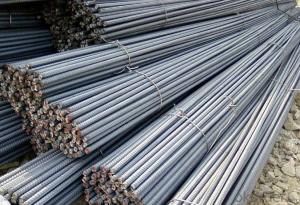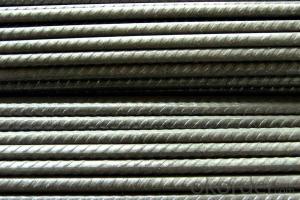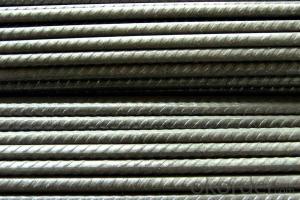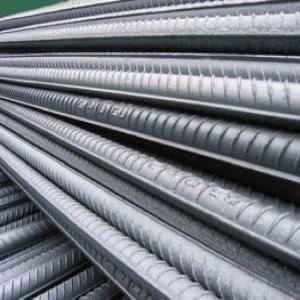High quality hot rolled deformed bar 6mm-50mm
- Loading Port:
- Tianjin
- Payment Terms:
- TT OR LC
- Min Order Qty:
- 25 m.t.
- Supply Capability:
- 20000000 m.t./month
OKorder Service Pledge
OKorder Financial Service
You Might Also Like
Product Description:
Product Description:
Specifications of HRB400 Deformed Steel Bar:
Standard | GB | HRB400 | |
Diameter | 6mm,8mm,10mm,12mm,14mm,16mm,18mm,20mm, 22mm,25mm,28mm,32mm,36mm,40mm,50mm | ||
Length | 6M, 9M,12M or as required | ||
Place of origin | Hebei, China mainland | ||
Advantages | exact size, regular package, chemical and mechanical properties are stable. | ||
Type | Hot rolled deformed steel bar | ||
Brand name | DRAGON | ||
Chemical Composition: (Please kindly find our chemistry of our material based on HRB500 as below for your information)
Grade | Technical data of the original chemical composition (%) | ||||||
C | Mn | Si | S | P | V | ||
HRB400 | ≤0.25 | ≤1.60 | ≤0.80 | ≤0.045 | ≤0.045 | 0.04-0.12 | |
Physical capability | |||||||
Yield Strength (N/cm²) | Tensile Strength (N/cm²) | Elongation (%) | |||||
≥400 | ≥570 | ≥14 | |||||
Theoretical weight and section area of each diameter as below for your information:
Diameter(mm) | Section area (mm²) | Mass(kg/m) | Weight of 12m bar(kg) |
6 | 28.27 | 0.222 | 2.664 |
8 | 50.27 | 0.395 | 4.74 |
10 | 78.54 | 0.617 | 7.404 |
12 | 113.1 | 0.888 | 10.656 |
14 | 153.9 | 1.21 | 14.52 |
16 | 201.1 | 1.58 | 18.96 |
18 | 254.5 | 2.00 | 24 |
20 | 314.2 | 2.47 | 29.64 |
22 | 380.1 | 2.98 | 35.76 |
25 | 490.9 | 3.85 | 46.2 |
28 | 615.8 | 4.83 | 57.96 |
32 | 804.2 | 6.31 | 75.72 |
36 | 1018 | 7.99 | 98.88 |
40 | 1257 | 9.87 | 118.44 |
50 | 1964 | 15.42 | 185.04 |
Usage and Applications of HRB400 Deformed Steel Bar:
Deformed bar is widely used in buildings, bridges, roads and other engineering construction. Big to highways, railways, bridges, culverts, tunnels, public facilities such as flood control, dam, small to housing construction, beam, column, wall and the foundation of the plate, deformed bar is an integral structure material. With the development of world economy and the vigorous development of infrastructure construction, real estate, the demand for deformed bar will be larger and larger..
Packaging & Delivery of HRB400 Deformed Steel Bar:
Packaging Detail: products are packed in bundle and then shipped by container or bulk vessel, deformed bar is usually naked strapping delivery, when storing, please pay attention to moisture proof. The performance of rust will produce adverse effect.
Each bundle weight: 2-3MT, or as required
Payment term: TT or L/C
Delivery Detail: within 45 days after received advanced payment or LC.
Label: to be specified by customer, generally, each bundle has 1-2 labels
Trade terms: FOB, CFR, CIF
- Q: Are there any limitations in using steel rebars in construction?
- Yes, there are limitations in using steel rebars in construction. Some of the limitations include susceptibility to corrosion, which can weaken the structure over time if not properly protected; limited flexibility compared to other materials, which may impact design options; and potential weight constraints in certain applications. Additionally, steel rebars can be expensive, requiring careful budgeting and cost considerations during construction projects.
- Q: What is the average lifespan of a reinforced concrete structure with steel rebars?
- The average lifespan of a reinforced concrete structure with steel rebars can vary depending on various factors such as design, construction quality, environmental exposure, and maintenance. However, with proper design, construction practices, and regular maintenance, reinforced concrete structures with steel rebars can typically last for several decades or even over a century.
- Q: How is steel rebar manufactured?
- Steel rebar is manufactured through a process called hot rolling, where steel billets are heated and passed through a series of rollers to shape them into the desired rebar size and form. This process involves various stages such as heating, roughing, finishing, and cooling, resulting in the production of high-quality steel rebar used in construction projects.
- Q: How do steel rebars perform in heavy load-bearing structures?
- Steel rebars perform exceptionally well in heavy load-bearing structures. Due to their high tensile strength and durability, they provide crucial reinforcement to concrete, effectively distributing and resisting heavy loads. This ensures structural integrity, preventing deformation and collapse even under extreme conditions.
- Q: What is the maximum length of steel rebars that can be manufactured?
- The maximum length of steel rebars that can be manufactured depends on various factors such as the manufacturing process, transportation limitations, and practical considerations. However, in general, steel rebars can be manufactured up to lengths of around 60 feet (18 meters).
- Q: What is the role of steel rebars in preventing structural vibrations?
- The role of steel rebars in preventing structural vibrations is to provide reinforcement and increase the stiffness of concrete structures. Steel rebars are embedded within the concrete, forming a skeletal framework that enhances the structural integrity and reduces the risk of vibrations. When a load or force is applied to a structure, such as wind or seismic activity, it can cause the structure to vibrate. These vibrations can lead to structural damage or even collapse if left unchecked. Steel rebars help mitigate these vibrations by absorbing and distributing the forces throughout the structure. By reinforcing the concrete, steel rebars increase the stiffness and strength of the structure, thereby reducing the amplitude of vibrations. They help to resist bending and torsional forces, ensuring that the structure remains stable and secure under various load conditions. Furthermore, steel rebars also play a crucial role in preventing progressive collapse. In the event of localized damage or failure, the rebars act as a safety net, redistributing the load and preventing a complete collapse. This is particularly important in high-rise buildings or structures with complex geometries, where the consequences of structural failure can be catastrophic. Overall, the presence of steel rebars in concrete structures significantly enhances their ability to withstand vibrations and external forces, ensuring the safety and longevity of the structure.
- Q: Can steel rebars be used in historical building restoration?
- Yes, steel rebars can be used in historical building restoration. Rebars are commonly used in construction to reinforce concrete structures and provide additional strength and durability. When it comes to historical building restoration, the goal is to preserve the original character and aesthetics of the structure while ensuring its structural integrity. Steel rebars can be carefully integrated into the restoration process to strengthen weak areas or replace deteriorated or damaged sections. The use of rebars allows for a more stable and long-lasting structure, ensuring the building's longevity for future generations. However, it is important to ensure that the use of steel rebars in historical building restoration is done in a way that respects the historical significance of the structure. The integration of rebars should be done discreetly, ensuring they do not compromise the building's original appearance or architectural features. Additionally, any restoration work on historical buildings should adhere to strict preservation guidelines and be carried out by skilled professionals with expertise in historical preservation. This ensures that the restoration process maintains the historical integrity of the building while incorporating necessary structural reinforcements, such as steel rebars.
- Q: Are steel rebars suitable for use in industrial facilities?
- Yes, steel rebars are suitable for use in industrial facilities. They provide excellent strength and durability, making them ideal for reinforcing concrete structures in such facilities. Steel rebars can withstand heavy loads and extreme conditions, ensuring the safety and long-term stability of industrial buildings and infrastructure.
- Q: Can steel rebars be used in dam construction?
- Yes, steel rebars can be used in dam construction. Steel rebars are commonly used in the construction of dams to reinforce concrete structures and provide added strength and durability. They help to withstand the immense pressure and weight of water, making them an essential component for dam stability and longevity.
- Q: How do steel rebars prevent concrete structures from spalling?
- Steel rebars prevent concrete structures from spalling by providing reinforcement and increasing the overall strength of the concrete. Spalling refers to the cracking and breaking off of the concrete surface, usually due to the expansion of internal pressure from various external factors such as temperature changes, moisture, or structural loads. When steel rebars are embedded within the concrete, they act as a support system that helps distribute the applied loads more evenly throughout the structure. This reinforcement prevents localized stress concentrations, which can lead to spalling, by absorbing and dissipating the load. By reinforcing the concrete, rebars enhance its tensile strength and improve its ability to withstand external forces. Moreover, steel rebars also help to control the formation of cracks in the concrete. As concrete is a brittle material with low tensile strength, it is prone to cracking under stress. However, the presence of rebars inhibits the propagation of cracks by bridging them and transferring the stress to the surrounding concrete. This prevents the cracks from spreading and ultimately leads to a more durable and resilient structure. Additionally, steel rebars provide protection against corrosion. Concrete is naturally alkaline, which creates a protective layer on the steel surface, preventing it from rusting. This alkaline environment acts as a barrier against corrosion, ensuring the rebars maintain their structural integrity over time. By avoiding corrosion, the rebars can continue to provide reinforcement and prevent spalling in the concrete structure. In summary, steel rebars play a crucial role in preventing spalling in concrete structures by providing reinforcement, improving tensile strength, controlling crack formation, and protecting against corrosion. By enhancing the overall stability and durability of the concrete, rebars ensure that the structure can withstand various external pressures and maintain its integrity for an extended period.
Send your message to us
High quality hot rolled deformed bar 6mm-50mm
- Loading Port:
- Tianjin
- Payment Terms:
- TT OR LC
- Min Order Qty:
- 25 m.t.
- Supply Capability:
- 20000000 m.t./month
OKorder Service Pledge
OKorder Financial Service
Similar products
Hot products
Hot Searches
Related keywords
